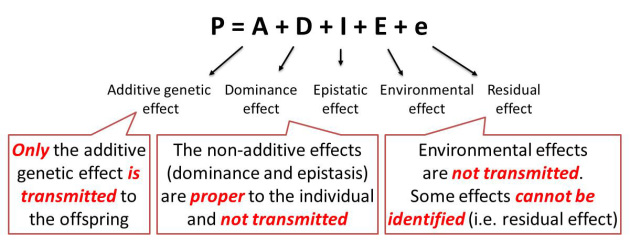Quantitative genetics
In 4.2 above, we focused on examples where one gene code for one trait (simple genetic determinism). However, interesting traits for dairy production, such as yields, fertility and health are coded by many genes, are controlled by several genes, and their expression is influenced by the environment.
Quantitative genetics is the study of the inheritance of traits that show a continuous distribution of phenotypes in a segregating population. Traits that are controlled by many genes also exhibit quantitative inheritance as each gene segregates in a Mendelian way. Even when there are only a few genes involved, the trait variation will show a continuous distribution due to the results of measurement error and environmental effects.
Quantitative genetics is considered to have been founded in the early 20th century, notably by R.A. Fisherâs article which showed that the inheritance of continuously varying traits is consistent with Mendelian principles.
The basic principle of quantitative genetics:
Basically, the phenotypic value (P) of an individual is the combined result of its genotype (G) and the effects of the environment (E):
![]()
Genotype refers to the total genetic variation. This includes not only the effects of nuclear genes, but also the effects of mitochondrial genes and the interactions between genes. Genotypic variation can be partitioned into additive and non-additive variation. Additive variation represents the cumulative effect of individual loci, therefore the overall mean is equal to the summed contribution of these loci.
Non-additive variation represents dominance variation (interaction between alleles) and epistasis variation (interaction between genes).
Quantitatively varying traits are also affected by environment (E). This can be further subdivided into pure environmental effect and interaction between genes and the environment. In other words, how different genotypes respond in different environments.
From the definition of the phenotype: P = G + E, we can see that there are two possible ways to improve a trait:
By improving the genotype through genetic selection. For example, the variation between cows for milk yield (some cows produce more milk than other), if results from genetic variation (which means that these cows will always produce more milk no matter the environment), allows genetic improvement.
By improving the environment through herd management.
Genetic variation is, therefore, the first component to genetic progress.






